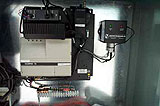Irrigation tools and technology
Since 1992 Parks has been implementing new ways to manage its water use. Irrigation technology can help The City in a number of ways – it saves water, improves turf quality, reduces pesticide use and cuts costs.
Irrigation technology
The City relies on the following components to manage our water resources and keep our parks and green spaces healthy.
Centralized computer control
The irrigation control centre provides the system operator with the tools needed to manage the irrigation system. A powerful computer and equally powerful software permit the operator to view the status of irrigation schedules, equipment performance, and more. Windows-based technology provides an easy point and click interface for the operator. Commands may be sent to modify the otherwise automatic operation of the irrigation system. Reports on the operation of the irrigation system may be generated. Central Control is saving an average of 44% on water use
Supervisory Control and Data Acquisition (SCADA)
A computer system for gathering and analyzing real time data, SCADA systems are used to monitor and control a plant or equipment in industries such as telecommunications, water and wastewater, energy, oil and gas refining as well as transportation. A SCADA system gathers information such as where a leak on a pipeline has occurred and transfers the information back to a central site, alerting the home station that the leak has occurred while carrying out the necessary analysis and control, such as determining if the leak is critical, and displaying the information in a logical and organized fashion. It also provides real-time data to the central control system. Calgary’s centralized irrigation control system is based on a SCADA system.
Other technological specifications
Piccolo XR
- A PICCOLO XR extends the range of the IRRInet CL where cable is expensive or difficult, can communicate up to 2000m of line of sight, operate as a store & forward repeater, utilizes a two-way low power UHF radio to communicate with a PICCOLO Interface unit.
IRRInet Remote Terminal Unit (RTU)
- Is a master field controller
- Controls valves at the field site
- Controls remote or slave controllers (Scorpio, IRRIcom)
- Has resident intelligence in Central Processing Unit (CPU)
Scorpio or IRRIcom Controller
- Remote controller operated by a master IRRInet controller
- Controls valves at the field site
- Reports back to IRRInet
- In remote operation has limited resident intelligence
- Can be set up as a "standalone" controller (resident intelligence without remote control)
Hydrometer or Meter/Master Valve (MMV)
- Wired to input on controller
- Controller reads when the switch opens and closes
- Controller calculates flow rate as irrigation system waters
- Can close down mainline if a leak is detected
Remote Sensors
Rain Switch
- Stop irrigations during localized events
- Switch circuit opens when wet
- Connected to input on controller
- Controller reads open circuit and will pause program
- Installed at IRRInet
Freeze Switch
- Prevents frost damage
- Switch circuit opens at or below 3 degrees Celsius (37.4 Fahrenheit)
- Connected to input on controller
- Controller reads open circuit and will stop program
- Installed at IRRInet
Weather Station
- Collects data on daily weather
- ICC calls daily via telephone
- Receives data and calculates daily Evapotranspiration (ET)
- ICC converts ET to Water Factor (WF) % adjustment and dispatches to (RTU)
Physical Plant
- Server (Windows XP, runs Motorola ICC software and Aqua Engineering Weather 2000 software)
- Motorola Field Interface Unit (FIU)
- 800 Mhz Base station radio
800 Mhz fully redundant repeater (Petro Canada building) - 113 IRRInets (currently using Super CPU)
- 690 Scorpio's and IRRIcom's (incl. linked units, 17-32 station)
- 6 dual monitor workstations (Windows XP)
- 6 laptops (Windows XP)
- 40 Field Programming Keyboards
- 8 PDAs
- Approx. 6 800 Mhz DTMF radios
- 5 VHF radios tuned to Scorpio frequency


